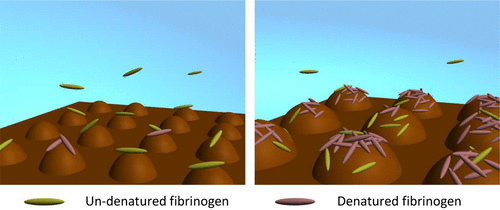Our official English website, www.x-mol.net, welcomes your
feedback! (Note: you will need to create a separate account there.)
Effect of the Molecular Weight of Poly(2-methoxyethyl acrylate) on Interfacial Structure and Blood Compatibility.
Langmuir ( IF 3.7 ) Pub Date : 2019-01-23 00:00:00 , DOI: 10.1021/acs.langmuir.8b02971 Daiki Murakami , Nami Mawatari , Toshiki Sonoda , Aki Kashiwazaki , Masaru Tanaka 1
Langmuir ( IF 3.7 ) Pub Date : 2019-01-23 00:00:00 , DOI: 10.1021/acs.langmuir.8b02971 Daiki Murakami , Nami Mawatari , Toshiki Sonoda , Aki Kashiwazaki , Masaru Tanaka 1
Affiliation

|
The blood-compatible polymer poly(2-methoxyethyl acrylate) (PMEA) is composed of nanometer-scale interfacial structures because of the phase separation of the polymer and water at the PMEA/phosphate-buffered saline (PBS) interface. We synthesized PMEA with four different molecular weights (19, 30, 44, and 183 kg/mol) to investigate the effect of the molecular weight on the interfacial structures and blood compatibility. The amounts of intermediate water and fibrinogen adsorption were not affected by the molecular weight of PMEA. In contrast, the degree of denaturation of adsorbed fibrinogen molecules and platelet adhesion increased as the molecular weight increased. Atomic force microscopy observation revealed that the domain size of the microphase separation structures observed at the PMEA/PBS interfaces drastically (nearly 3 times in the mean area of a domain) changed with the molecular weight. PMEA with a lower molecular weight showed a smaller polymer-rich domain size, as expected on the basis of the microphase separation of polymer-rich and water-rich domains. The small domain size suppressed the aggregation and denaturation of adsorbed fibrinogen molecules because only a few fibrinogen molecules were adsorbed on a domain. Increasing the domain size enhanced the denaturation of adsorbed fibrinogen molecules. Controlling the interfacial structures is crucial for ensuring the blood compatibility of polymer interfaces.
中文翻译:

聚(丙烯酸2-甲氧基乙酯)的分子量对界面结构和血液相容性的影响。
血液相容性聚合物聚(丙烯酸2-甲氧基乙酯)(PMEA)由纳米级界面结构组成,这是因为聚合物与水在PMEA /磷酸盐缓冲盐水(PBS)界面处发生相分离。我们合成了四种分子量(19、30、44和183 kg / mol)的PMEA,以研究分子量对界面结构和血液相容性的影响。中间水和纤维蛋白原的吸附量不受PMEA分子量的影响。相反,随着分子量增加,吸附的纤维蛋白原分子的变性程度和血小板粘附性增加。原子力显微镜观察显示,在PMEA / PBS界面处观察到的微相分离结构的域大小急剧变化(域平均面积的近3倍)随分子量变化。分子量较低的PMEA显示出较小的富聚合物域尺寸,这是基于富聚合物域和富水域的微相分离所预期的。小的畴尺寸抑制了吸附的纤维蛋白原分子的聚集和变性,因为只有很少的纤维蛋白原分子被吸附在一个畴上。增大域尺寸可增强吸附的纤维蛋白原分子的变性。控制界面结构对于确保聚合物界面的血液相容性至关重要。分子量较低的PMEA显示出较小的富聚合物域尺寸,这是基于富聚合物域和富水域的微相分离所预期的。小的畴尺寸抑制了吸附的纤维蛋白原分子的聚集和变性,因为只有很少的纤维蛋白原分子被吸附在一个畴上。增大域尺寸可增强吸附的纤维蛋白原分子的变性。控制界面结构对于确保聚合物界面的血液相容性至关重要。分子量较低的PMEA显示出较小的富聚合物域尺寸,这是基于富聚合物域和富水域的微相分离所预期的。小的畴尺寸抑制了吸附的纤维蛋白原分子的聚集和变性,因为只有很少的纤维蛋白原分子被吸附在一个畴上。增大域尺寸可增强吸附的纤维蛋白原分子的变性。控制界面结构对于确保聚合物界面的血液相容性至关重要。增大域尺寸可增强吸附的纤维蛋白原分子的变性。控制界面结构对于确保聚合物界面的血液相容性至关重要。增大域尺寸可增强吸附的纤维蛋白原分子的变性。控制界面结构对于确保聚合物界面的血液相容性至关重要。
更新日期:2019-01-23
中文翻译:

聚(丙烯酸2-甲氧基乙酯)的分子量对界面结构和血液相容性的影响。
血液相容性聚合物聚(丙烯酸2-甲氧基乙酯)(PMEA)由纳米级界面结构组成,这是因为聚合物与水在PMEA /磷酸盐缓冲盐水(PBS)界面处发生相分离。我们合成了四种分子量(19、30、44和183 kg / mol)的PMEA,以研究分子量对界面结构和血液相容性的影响。中间水和纤维蛋白原的吸附量不受PMEA分子量的影响。相反,随着分子量增加,吸附的纤维蛋白原分子的变性程度和血小板粘附性增加。原子力显微镜观察显示,在PMEA / PBS界面处观察到的微相分离结构的域大小急剧变化(域平均面积的近3倍)随分子量变化。分子量较低的PMEA显示出较小的富聚合物域尺寸,这是基于富聚合物域和富水域的微相分离所预期的。小的畴尺寸抑制了吸附的纤维蛋白原分子的聚集和变性,因为只有很少的纤维蛋白原分子被吸附在一个畴上。增大域尺寸可增强吸附的纤维蛋白原分子的变性。控制界面结构对于确保聚合物界面的血液相容性至关重要。分子量较低的PMEA显示出较小的富聚合物域尺寸,这是基于富聚合物域和富水域的微相分离所预期的。小的畴尺寸抑制了吸附的纤维蛋白原分子的聚集和变性,因为只有很少的纤维蛋白原分子被吸附在一个畴上。增大域尺寸可增强吸附的纤维蛋白原分子的变性。控制界面结构对于确保聚合物界面的血液相容性至关重要。分子量较低的PMEA显示出较小的富聚合物域尺寸,这是基于富聚合物域和富水域的微相分离所预期的。小的畴尺寸抑制了吸附的纤维蛋白原分子的聚集和变性,因为只有很少的纤维蛋白原分子被吸附在一个畴上。增大域尺寸可增强吸附的纤维蛋白原分子的变性。控制界面结构对于确保聚合物界面的血液相容性至关重要。增大域尺寸可增强吸附的纤维蛋白原分子的变性。控制界面结构对于确保聚合物界面的血液相容性至关重要。增大域尺寸可增强吸附的纤维蛋白原分子的变性。控制界面结构对于确保聚合物界面的血液相容性至关重要。































 京公网安备 11010802027423号
京公网安备 11010802027423号